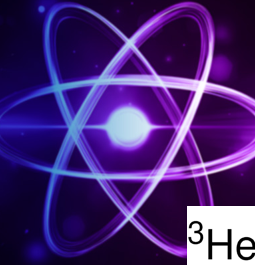Helium-3
A key gas for advanced research
Helium-3 (³He) is a rare, stable isotope of helium characterized by a nuclear spin of ½ and a very low atomic mass. Its exceptional cryogenic and nuclear properties make it a strategic gas for a wide range of advanced scientific and industrial applications. Used in low-temperature physics, neutron detection, and fusion research, Helium-3 plays a key role in cutting-edge innovatio
Physical Properties and Advantages
Helium-3 has an extremely low boiling point (3.19 K at 1 atm) and remains stable across a wide range of pressures and temperatures.
Its main features include:
-
Low density and chemical inertness, ensuring safe and predictable handling in cryogenic systems.
-
High neutron capture efficiency, enabling selective and sensitive detection.
-
Unique quantum behavior at ultra-low temperatures, essential for fundamental research.
These properties make ³He a reference fluid for high-precision experimental and industrial devices.
Scientific and Industrial Applications
Advanced Cryogenics and Low-Temperature Physics
Helium-3 plays a crucial role in the field of cryogenics, particularly in dilution refrigerators (³He/⁴He), which are capable of achieving temperatures below 0.3 K—close to absolute zero. At such extreme conditions, conventional materials and systems exhibit remarkable quantum properties, making helium-3 an indispensable resource for cutting-edge research and technology development.
These systems are essential for:
-
Fundamental quantum research: enabling the study of phenomena such as superconductivity, superfluidity, and Bose–Einstein condensates, which reveal the behavior of matter under quantum regimes.
-
Space science and instrumentation: providing ultra-low-temperature cooling for space telescopes, particle detectors, and infrared sensors, where thermal noise reduction is critical for high-precision measurements.
-
Beyond research, helium-3’s unique thermodynamic properties continue to inspire innovations across materials science, astrophysics, and advanced instrumentation.
-
Next-generation technologies: supporting the development of cryoelectronic components, quantum circuits, and quantum computing systems, where helium-3 ensures temperature stability and optimal performance of qubits.
Neutron Detection
Thanks to its exceptionally high thermal neutron capture cross-section, helium-3 remains the reference gas for neutron proportional counters and related detection systems. Its unique nuclear properties make it highly efficient, reliable, and selective for identifying and measuring neutron fluxes in a wide range of scientific and industrial applications.
Helium-3 detectors are employed in:
-
Nuclear safety and fissile material monitoring: ensuring the detection and control of neutron emissions from nuclear facilities, waste storage, and transport systems.
-
Reactor physics and radiation protection research: supporting neutron flux characterization, dosimetry, and shielding studies to improve reactor efficiency and enhance personnel safety.
-
With its proven sensitivity and stability, helium-3 continues to be a cornerstone of neutron detection technologies.
-
Neutron imaging and non-destructive analysis: enabling high-resolution imaging of materials and structures, crucial for materials science, aerospace, and industrial quality control.
Hyperpolarized Medical Imaging
Hyperpolarized gas MRI using helium-3 (He-3) and xenon-129 (Xe-129) has revolutionized lung imaging by enabling high-resolution visualization of ventilation and gas exchange. Here's how they work together and what makes each unique:
Why Use Helium-3 and Xenon-129 Together?
-
Helium-3 excels at visualizing lung ventilation due to its high diffusivity and signal strength. It provides detailed maps of airflow and structural abnormalities like airway obstructions or emphysema.
-
Xenon-129 offers additional functional insights because it dissolves into lung tissue and blood, allowing assessment of gas exchange and perfusion. It can also probe tissue microstructure and detect early signs of disease.
-
Combined use enables simultaneous imaging of ventilation and gas exchange, offering a more comprehensive view of lung health than either gas alone.
Advanced Nuclear Fusion
Helium-3 is also studied as a potential fuel for deuterium–helium-3 (D–³He) fusion reactors.
This nearly aneutronic reaction offers clean energy production with minimal secondary radiation.
International research projects are investigating its feasibility as a promising path toward sustainable, waste-free nuclear energy.


